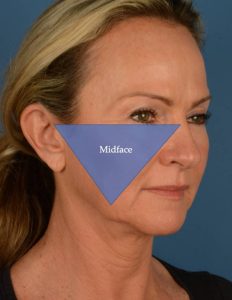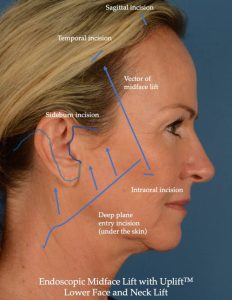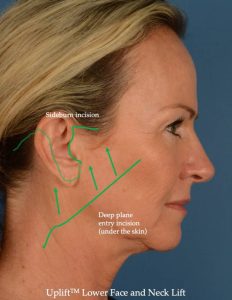Endoscopic Midface Lift
Facelift surgeries often involve complicated terms that can be confusing. This guide explains the differences between the endoscopic midface lift, deep plane facelift, and uplift lower face and neck lift. It helps you make an informed decision. The choice of technique depends on the surgeon’s training, experience, and preferences. Each method can deliver great results when the surgeon clearly understands the patient’s expectations.
Table of Contents
ToggleThe Deep Plane Facelift
Operating in the “deep plane” offers many benefits. This technique lifts the facial muscles and layers below them, usually beneath the SMAS (superficial musculoaponeurotic system) and sometimes under the platysma muscle. The procedure raises the midface by lifting the cheek at a 45-degree angle. It often requires an incision around the temporal hairline to reposition and remove extra skin. While this approach can work well, some patients find the pre-temporal hairline scar noticeable when styling their hair. Some heal well, but others prefer to keep their hair down to hide the scar.

Endoscopic Midface Lift Techniques
The endoscopic midface lift technique targets the area just above the facial bones, beneath the periosteum. This procedure uses an endoscope to access the cheek through three small incisions: one above the hairline near the outer eyebrow, another behind the temporal hairline, and the third inside the upper lip. These hidden incisions allow for a vertical lift, aligning with the natural aging process. Repositioning the periosteum offers a more durable outcome compared to lifting the muscle layer and malar fat, as seen in the deep plane lift.
This technique also forms the basis for endoscopic forehead and brow lifts, which have largely replaced traditional coronal brow lifts with large scalp incisions. Although neither deep plane facelifts nor endoscopic midface lifts consistently improve the nasolabial fold, both can produce remarkable results.

The Uplift Lower Face and Neck Lift
The Uplift™ Lower Face and Neck Lift incorporates many deep plane facelift techniques but does not lift the midface. This method lifts the SMAS and platysmal layers along with the skin. The SMAS incision is more horizontal, creating a vertical lift of the jawline and neck to counteract natural aging. Often combined with the endoscopic midface lift, this approach rejuvenates both the cheek and jawline with hidden incisions and longer-lasting results.

Advantages of the Endoscopic Midface Lift
- Vertical Elevation: The procedure lifts the cheek in a vertical direction, aligning with the natural aging process.
- No Temporal Hairline Incision: It avoids the visible scarring associated with deep plane facelifts.
- Increased Cheek Volume: By infolding the cheek periosteum, it adds volume and counters age-related deflation.
- Concealed Incisions: Small, hidden incisions reduce visible scarring.
- Multi-Layered Support: When combined with the Uplift™ technique, it enhances the stability and durability of results.
Disadvantages of the Endoscopic Midface Lift
- Longer Surgery Time: It requires about one and a half hours more than other facelift techniques.
- Specialized Equipment: The procedure needs specialized endoscopic instruments, which may not be available in all centers.
- Increased Infection Risk: The intraoral incision can increase infection risk due to the mouth’s bacteria-rich environment.
- Potential for Vein Prominence: Some patients may notice more prominent veins around the eyes after surgery.
- Prolonged Cheek Swelling: Patients may experience longer cheek swelling compared to the deep plane facelift.
Choosing the Right Procedure
The decision between an endoscopic midface lift and a deep plane facelift depends on your goals, anatomy, and the surgeon’s recommendations. Each procedure offers unique advantages and challenges, so a thorough consultation with a qualified plastic surgeon is essential for determining the best approach to achieve your desired results.

